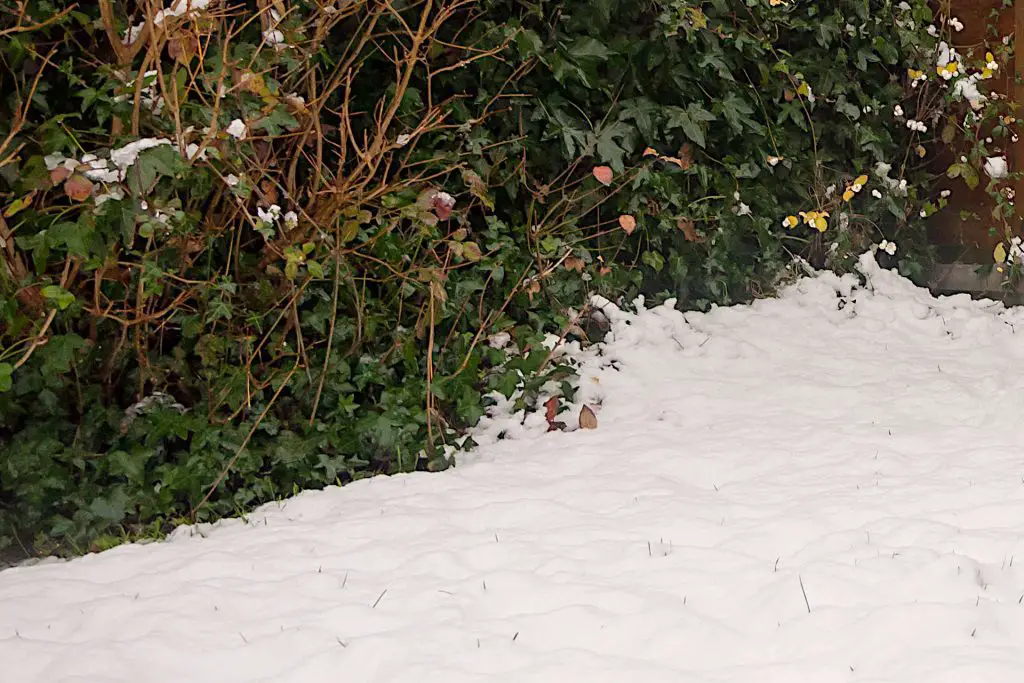How Decomposition Slows Down In Cold Weather – Composting Basics
- Cold weather affects the speed at which organic material is broken down and turned into humus.
- Lower pile temperatures can prevent pathogens and weed spores that may be present from being totally destroyed.
- If the temperature of the pile falls below around 45°F the pile enters a state of dormancy.
- The effect of cold weather is much greater on the hot composting process than cold or passive composting.
- There are alternative ways of composting that can take the effect of cold or freezing weather out of the equation.
Composting is one of the best ways of utilizing organic material that is usually so abundant in winter. The problem is cold weather can adversely affect the decomposition process causing it to slow down or even stop completely if the pile freezes.
If you understand exactly what is happening to the decomposition process inside your pile as the temperature drops it can help you mitigate the worst effects of cold temperatures. We provide some advice and tips on how better prepare your pile for composting over winter.
How Temperature Changes Affect Decomposition

With traditional compost piles, the process by which organic material is broken down into humus is caused by fungi and the production of microorganisms. The hotter the temperature of the pile the more microorganisms are produced and the faster the decomposition occurs. The optimum temperature at which decomposition takes place is between 100°F and 140°F.
Over the winter it becomes more difficult to maintain the core temperature in the pile. If the temperature drops below 90°F, although the decomposition process continues, it is possible that not all the weed seeds or pathogens will be killed off.
Below 65°F the only group of microorganisms that function is psychrophiles, which are the main constituent microbes of cold composting. These break down the organic material much more slowly. The colder the pile gets the slower the process of decomposition becomes and once the temperature falls below 32°F it becomes suspended as the microbes are unable to function at this temperature.
What is the Decomposition Timespan?

Gardeners build their compost piles and follow either a cold or hot composting process. In many respects, they are fairly similar processes, differing mainly in the carbon-to-nitrogen ratio and the active management of the piles.
However, the time to finished compost can be dramatically different between the two approaches. With cold composting it takes around six months or more, depending on the makeup of the pile and how passive the prosses is.
Hot composting drastically reduces this timespan. With hot composting, the core pile temperature should reach between 115 and 140°F the point at which Thermophilic microorganisms become active drastically increasing the decomposition rate. This has the effect of reducing the time to finished compost to three months or less.
The Effect on Cold Composting
If you are following a cold composting or passive composting process, the core temperature of a pile at which the decomposition takes place is between 65°F and 90°F. During cold weather, this can drastically drop causing the pile to enter into a semi-dormant state.
When the temperatures pick up again above freezing the decomposition will start again and gradually pick up as the weather becomes warmer. The downside is that the time it takes to get to the finished compost that you can use is extended.
You might ask the question does the cold weather really matter with cold composting, as it usually takes six months to reach the finished compost state? The answer is that it probably won’t make that much difference.
In reality, if you are starting the pile in October or November to take advantage of the abundant supply of organic material around, depending on the carbon-to-nitrogen ratio, you are likely to see finished compost by June or July, earlier if the winter is mild.
Of course, you can mitigate against some of the cold weather by preparing your organic materials properly and insulating the compost pile.
The Effect on Hot Composting

Cold weather has a much more dramatic effect if you are following the hot composting process. This relies on maintaining the core temperature of the compost pile above 115°F. This allows the decomposition process to go from the Mesophilic phase into the Thermophilic phase, maintaining the increased microbe activity required for fast decomposition.
In freezing weather, it is likely to be a battle to prevent the temperature of the pile to drop below 115°F, thus slowing down the time to finished humus. The good news is that if you are very scientific about the carbon-to-nitrogen ratios and you have the time to turn the pile every couple of days, you can see finished compost in as little as 8 weeks! So, if you started your pile in late October or early November you could beat the cold weather.
Insulating your pile is of course another option but you would probably need to build a closed compost bin to be able to truly maintain the heat inside the pile.
How to Take Cold Weather out Of the Equation
We have concentrated on the most traditional and probably the most common ways gardeners compost. However, there are alternative ways in which you can compost more efficiently in winter without having to worry too much about freezing temperatures. You can read more about the six most effective ways to compost in winter here.
